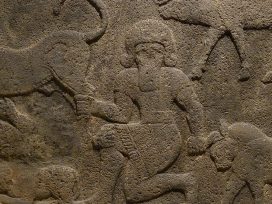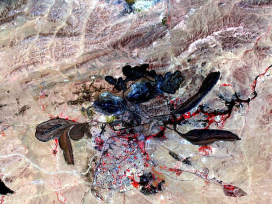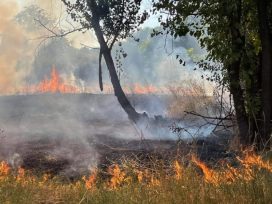When Martin Luther nailed his “Ninety-Five Theses” to the door of Wittenberg’s All Saints’ Church, he sought to start a conversation about reform. Yet his ideas sparked something that eventually came to look rather more like a revolution. As far as I am aware, Dipesh Chakrabarty has not nailed his “Four theses” to any doors at the University of Chicago, but perhaps he should. The satisfying “thunk” of nail in wood would provide an appropriate note of material solidity to Chakrabarty’s provocative ideas that – at least to my reading – pose a powerful challenge to the modernist illusion that we humans are separate from the material world around us. Humanism may never be the same again.
I am not sure that Chakrabarty intended anything quite so bold as a reformation of the humanistic disciplines. Nonetheless, in the context of the recent efflorescence of neomaterialist and posthumanist thinking in a variety of scholarly fields, his “Four theses” may prove more radical than even he intended, or perhaps desires. Indeed, his first thesis is by most academic measures already plenty radical. Chakrabarty proposes that the advent of anthropogenic climate change spells “the collapse of the age-old humanist distinction between natural history and human history”. From Vico to Collingwood to Carr, most historians have taken it as largely self-evident that whatever remained natural about human beings – mostly just their bodies – had no real history, while the rest of the nonhuman world was the province of an entirely distinct “natural history”. Real history only commenced when humans began to do unnatural things: cultivate crops, make tools, build cities, and create societies and cultures. In this view, humans had a history that was in proportion to the extent to which they were unnatural and cultural.
Anthropogenic climate change, however, has breached this once seemingly impregnable wall of separation. The unnatural power of human society and technology has grown so great that it has, ironically, come full circle to become natural again: a force of nature comparable to the Earth’s orbital permutations, plate tectonics, or the impact of a massive asteroid. Chakrabarty argues that, as humans become such a “geophysical force”, conventional humanistic distinctions between human culture and nature collapse. Neither “subject nor object”, such a force of nature is simply “the capacity to move things”. This is a consequence of human creativity and history, yet it possesses neither, and is instead akin to “some nonhuman, nonliving agency”. With anthropogenic climate change, humans must be understood both as unnatural self-created creatures and a natural force – what Chakrabarty terms “the human-human and the nonhuman-human”.
In essence, Chakrabarty’s brilliance is to clearly identify here what we might term the Great Ontological Collapse. Many humans, particularly those under the seductive spell of Western Enlightenment thought, had for centuries insisted that they existed on a plane far above the base material world around them because their ontology was one of creation and self-creation. Humans were subjects, never objects. Indeed, as Chakrabarty notes, such anthropocentric hubris was often closely tied to the new religions that evolved in the wake of the Neolithic revolution and urban settlement. Attempting to explain their seeming divergence from other animals and the natural world, city dwellers often concluded that a supernatural god must have granted them some part of its own divine and immaterial essence. Centuries later, Enlightenment thinkers secularized the immaterial soul, replacing it with a sort of “Soul 2.0”, one inherent in an abstracted and disembodied concept of the human intellect and culture: we think, therefore we create.
Yet what happens when humans’ thinking and creating results not in their transcendence of nature, but their abrupt descent back into it? This is precisely the phenomenon occurring with anthropogenic global warming, Chakrabarty suggests. Humans have not “slipped the surly bonds of Earth”, but find themselves bonded ever more tightly to the most fundamental earthly phenomena. To be sure, some have already begun to take a certain pride in having achieved such a powerful effect, suggesting that it is perhaps now the destiny of humans to fully master and reengineer the planet. The Australian ethicist Clive Hamilton notes that the so-called “ecopragmatists”, such as Michael Shellenberger and Ted Nordhaus of the “neogreen” Breakthrough Institute, have begun to argue that humans can engineer a “Good Anthropocene”. Some advocates of this optimistic view – what Hamilton aptly calls the Promethean position – argue that humans can manage the effects of global warming through gigantic geoengineering projects. Yet Chakrabarty rightly cautions against such anthropocentric hubris, proposing that this new world-altering geophysical force is unthinking and unintended, a “beast” that humans have unleashed more than created, and clearly not one that they control. Far from escaping the bonds of a weak and passive Earth, humans are instead revealed to be the creations of a powerful and creative Earth. The distinction between human and natural ontologies is at an end.
This is a profoundly important insight, and I suspect that its implications may be more radical than even Chakrabarty suggests. Having recognized how climate change collapses the divide between human and natural history, it becomes reasonable to ask whether there was ever a divide in the first place. We begin to contemplate the heretical thought that perhaps humans never left nature, that we have always been a force or product of the natural material world, even if only recently a geophysical one. For this claim to make sense demands that we take on the even broader modernist distinction between culture and nature, and ask how human intelligence, creativity, and inventiveness are not above the material world but rather products of it. Until recently, most scholars have assumed that nonhuman organisms and things might at most simply influence a distinctly separate sphere of human culture through some ill-defined abstract process. Indeed, culture was frequently understood as standing in opposition to nature.
To the degree that nonhuman things were understood as cultural – as implied, say, in the phrase “material culture” – it was solely because humans had put the culture there. In the conventional anthropocentric view, human culture was infinitely creative and mutable while everything else on the planet was often understood as largely passive and fixed – mere “natural resources” or “raw materials”. Given this interpretation, cultural phenomena like social power, intelligence, or creativity could never, in and of themselves, be understood as material things.
These old verities are now giving way, thanks in part to the new ways of thinking made possible by global climate change. Environmental historians, neo-materialists, and posthumanist thinkers in a variety of disciplines have begun to suggest the many ways in which human culture is inseparable from the material world. Chakrabarty cites Daniel Smail’s important argument that cultural history can be analysed at least somewhat as a product of the biological nature of the human brain. The environmental historian Edmund Russell demonstrates how the British Industrial Revolution – so central to anthropogenic climate change – was in significant part the product of the genetic creativity of a New World cotton plant. In my own work, I have argued that what is typically understood as solely human intelligence behind the open-range stock industry in the United States was also the product of the cattle’s own highly social intelligence.
At the same time, new materialist scholars have pushed us to consider how many other aspects of human sociocultural existence are materially grounded. In her argument for a “vital materialism”, political theorist Jane Bennett argues that we need to rethink the power of humans: “not by denying humanity’s awesome, awful powers, but by presenting these powers as evidence of our own constitutions as vital materiality”. In his recent career-defining magnum opus, the French anthropologist Philippe Descola exhorts scholars to move “beyond nature and culture”, perhaps in part by taking inspiration from the many non-Western peoples whose animistic worldviews render such a dichotomy largely nonsensical. In sum, these new ideas suggest that we humans derive much of what we like to think of our power, intelligence, and creativity, from the material things around us. Indeed, in many ways these things are understood as constituting who we are.
Many of these neo-materialist insights resonate with Chakrabarty’s thesis. However, they also posit a further question: How did humans become a geological force of nature in the first place? Intent on exploring the consequences, Chakrabarty says less about the causes, though he suggests that “we have stumbled into it” through the process of industrialization. Provocatively, he also refuses (I think rightly) to make any causal distinction “between the capitalist and socialist societies we have had so far, for there was never any principled difference in their use of fossil fuel”. In this I suspect Chakrabarty points to what neo-materialists might suggest was the first source of this human geophysical power: not their social and cultural inventiveness, nor their various political economies, but rather their relations with the material power of the coal and oil that helped to create them all.
“The mansion of modern freedoms stands on an ever-expanding base of fossil-fuel use”, Chakrabarty elegantly writes. Yet are fossil fuels only the base of human freedom, or do they in some logical sense create and constitute that freedom? In collapsing human and natural ontologies, it becomes possible to understand coal and oil as creative ontological forces, to suggest that humans do not use fossil fuels so much as they become entangled with and created by them. Timothy Mitchell argues that the material nature of coal not only helped create modern democracy, but also in a deeper sense constitutes that democracy. Transforming coal into a useful commodity, Mitchell argues, involved “establishing connections and building alliances . . . that do not respect any divide between material and ideal” or even between the “human and nonhuman”.
In sum, Chakrabarty’s “Four theses” suggest that the material reality of global climate change is also helping us to create new ideas, behaviours, and cultures. His insights derive from the present crisis, yet I suspect they are equally essential to understanding the past. It is difficult to predict what the history of the “nonhuman human” – the human who is as much coal, oil, and other things as culture and ideas – might look like. But I think it is safe to say that phenomena like justice and freedom, as well as their opposites, will increasingly be understood not solely as human ideas or creations, but as products of the powerful material things we partner with. In this, Chakrabarty’s “Four theses” may indeed herald an impending academic reformation: the emergence of a nonhuman humanism.
Selected sources
Bennett, Jane. Vibrant Matter: A Political Ecology of Things. University of North Carolina Press, 2010.
Boivin, Nicole. Material Cultures, Material Minds. Cambridge University Press, 2008.
Descola, Philippe. Beyond Nature and Culture. Translated by Janet Lloyd. University of Chicago Press, 2013.
Hodder, Ian. Entangled: An Archaeology of the Relationship between Humans and Things. Wiley-Blackwell, 2012.
Russell, Edmund. Evolutionary History: Uniting History and Biology to Understand Life on Earth. Cambridge University Press, 2011.
Smail, Daniel Lord. Deep History and the Brain. University of California Press, 2008.
This article was first published in RCC Perspectives 2/2016.






